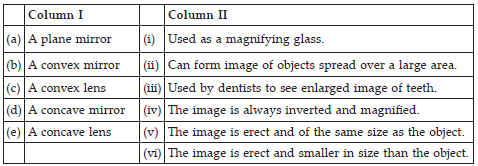Light (Physics) Class 7 - NCERT Questions
Fill in the blanks:
(A) An image that cannot be obtained on a screen is called _______.
(B) Image formed by a convex _______ is always virtual and smaller in size.
(C) An image formed by a ______ mirror is always of the same size as that of the object.
(D) An image which can be obtained on a screen is called a _______ image.
(E) An image formed by a concave _______ cannot be obtained on a screen.
(A) virtual image, (B) mirror, (C) plane, (D) real, (E) lens
Q 2.Mark ′T′ if the statement is true and ′F′ if it is false:
(A) We can obtain an enlarged and erect image by a convex mirror. (T/F)
(B) A concave lens always form a virtual image. (T/F)
(C) We can obtain a real, enlarged and inverted image by a concave mirror. (T/F)
(D) A real image cannot be obtained on a screen. (T/F)
(E) A concave mirror always form a real image. (T/F)
(A) False, (B) True, (C) True, (D) False, (E) False
Q 3.Match the items given in Column I with one or more items of Column II.

(A)-(v); (B)-(ii), (vi); (C)-(i); (D)-(iii), (E)-(vi)
Q 4.State the characteristics of the image formed by a plane mirror.
SOLUTION:The image formed by a plane mirror has the following characteristics:
(i) The distance of the object in front of the mirror is same as the distance of the image behind the mirror.
(ii) The image formed by a plane mirror is virtual and erect.
(iii) The size of the image is equal to the object size.
Find out the letters of English alphabet or any other language known to you in which the image formed in a plane mirror appears exactly like the letter itself. Discuss your findings.
SOLUTION:The letters of English alphabet which give exactly same image in a plane mirror like the letter itself are :
A, H, I, M, O, T, U, V, W, X, Y
What is a virtual image? Give one situation where a virtual image is formed.
SOLUTION:The image formed by the plane mirror appears behind it. We cannot however touch it. Also, the image of the object cannot be obtained on a screen whether it is held in front of the mirror or behind it. Such types of images are not real. They are virtual images.
Q 7.State two differences between a convex and a concave lens.
SOLUTION: 
Give one use each of a concave and a convex mirror.
SOLUTION:Concave mirror : Used by dentists to obtain a large virtual image of the teeth.
Convex mirror : Used in vehicles as rear view mirrors, since they form the image of objects spread over a large area.
Which type of mirror can form a real image?
SOLUTION:Concave mirror can form a real image.
Q 10.Which type of lens forms always a virtual image?
SOLUTION:Concave lens always forms a virtual image.
Q 11.A virtual image larger than the object can be produced by a
(i) concave lens (ii) concave mirror
(iii) convex mirror (iv) plane mirror
(ii)
Q 12.David is observing his image in a plane mirror. The distance between the mirror and his image is 4 m. If he moves 1 m towards the mirror, then the distance between David and his image will be
(i) 3 m (ii) 5 m (iii) 6 m (iv) 8 m
(iii) : If David moves 1 m towards the mirror, then distance between his image and mirror
= 4 – 1 = 3 m
So, distance between David and mirror = 3 m
Hence, distance between David and his image = 3 + 3 = 6 m
The rear view mirror of a car is a plane mirror. A driver is reversing his car at a speed of 2 m/s. The driver sees in his rear view mirror the image of a truck parked behind his car. The speed at which the image of the truck appears to approach the driver will be
(i) 1 m/s (ii) 2 m/s (iii) 4 m/s (iv) 8 m/s
(iii)